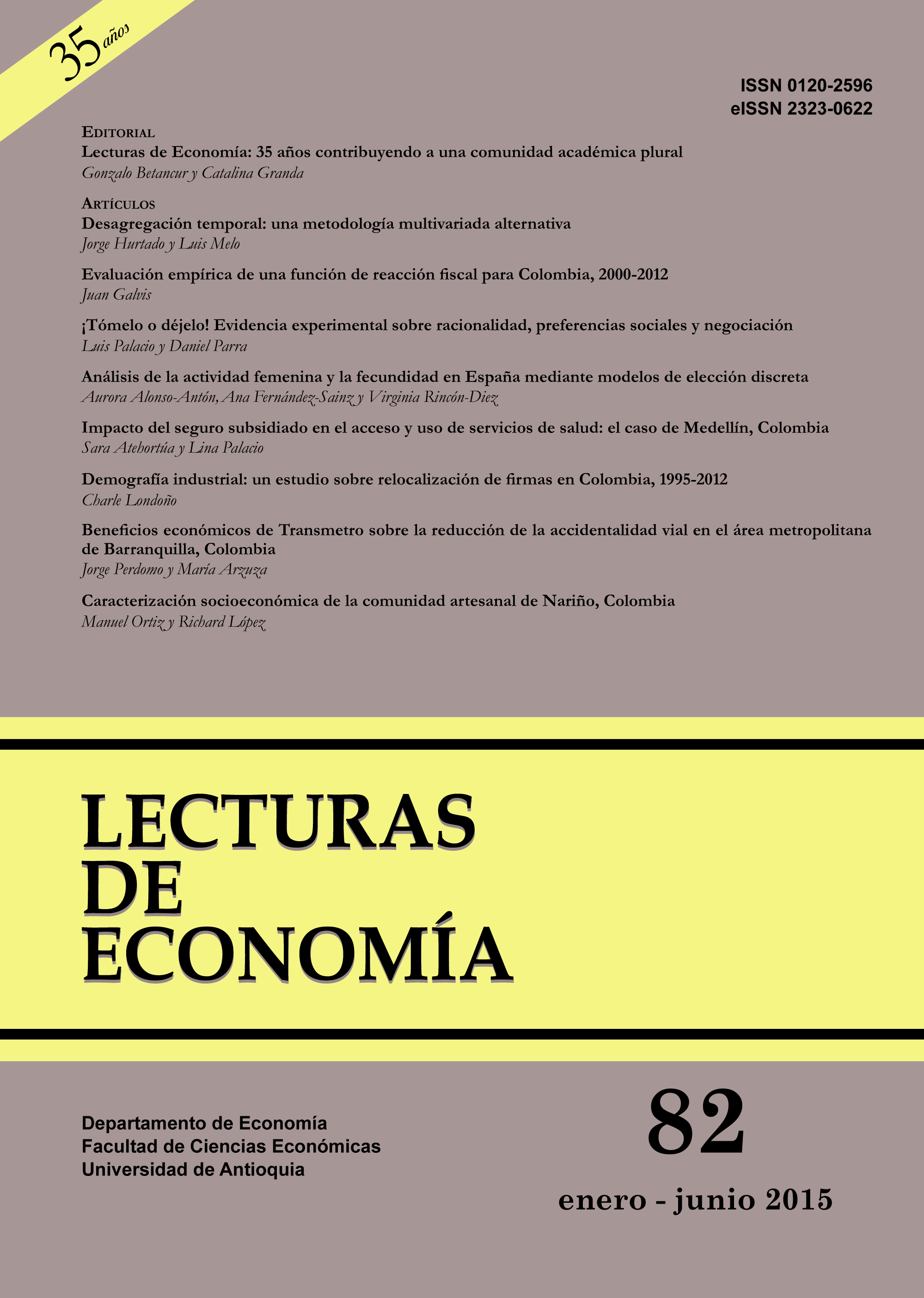Temporal disaggregation: an alternative multivariate methodology
DOI:
https://doi.org/10.17533/udea.le.n82a1Keywords:
Temporal disaggregation, temporal and contemporaneous aggregation constraintsAbstract
In this paper we propose a new extension of Di-Fonzo (1990)’s methodology for multivariate temporal disaggregation. We assume that the errors of the high-frequency series follow a VAR(1) model instead of a white noise process. Additionally, an extensive review of different univariate and multivariate disaggregation methods is presented. Finally, we carry out a multivariate application to obtain Colombia’s monthly national accounts from quarterly data. The results obtained using the proposed methodology are similar to those with Di-Fonzo’s method. However, our resulting series are less volatile.
Downloads
References
Barcellan, Roberto (2002). “ECOTRIM: a program for temporal disaggregation of time series”. In: Barcellan, Roberto y Mazzi, Luigi (Eds.), Workshop on Quarterly National Accounts (pp. 79-95). Luxembourg: Eurostat.
Cavero, Jesús; Fernández-Abascal, Hermenegildo; Gómez, Isabel; Lorenzo, Carlota; Rodríguez, Beatriz; Rojo, José Luis y José Antonio Sanz (1994). “Hacia un modelo trimestral de predicción de la economía Castellano-Leonesa. El modelo hispalink CyL”, Cuadernos Aragoneses de Economía, Vol. 4, No. 2, pp. 317-343.
Chow, Gregory y Lin An-L (1971). “Best linear unbiased interpolation, distribution, and extrapolation of time series by related series”, Review of Economics and Statistics, Vol. 53, Issue 4, pp. 372–375.
Denton, Frank (1971). “Adjustment of monthly or quarterly series to annual totals: An approach based on quadratic minimization”, Journal of the American Statistical Association, Vol. 66, Issue 333, pp. 99–102.
Di-Fonzo, Tommaso (1987). La stima indiretta di serie economiche trimestrali. Padova: CLEUP.
Di-Fonzo, Tommaso (1990). “The estimation of M disaggregate time series when contemporaneous and temporal aggregates are known”, The Review of Economics and Statistics, Vol. 72, Issue 1, pp. 178–182.
Di-Fonzo, Tommaso (2002). “Temporal disaggregation of a system of time series when the aggregate is known: optimal vs. adjustment methods”. In: Barcellan, Roberto y Mazzi, Luigi (Eds.), Workshop on Quarterly National Accounts (pp. 63-77). Luxembourg: Eurostat.
Fernández, Roque (1981). “A methodological note on the estimation of time series”, The Review of Economics and Statistics, Vol. 63, Issue 3, pp. 471–476.
Guerrero, Víctor (1990). “Temporal disaggregation of time series: an ARIMA-based approach”, International Statistical Review, Vol. 58, pp. 111–120.
Hurtado, Jorge Luis y Melo, Luis Fernando (2010). “Una metodología multivariada de desagregación temporal”, Borradores de Economía 586. Banco de la República.
Litterman, Robert (1983). “A random walk, Markov model for the distribution of time series”, Journal of Business and Economic Statistics, Vol. 1, Issue 2, pp. 169–173.
Lupi, Claudio y PARIGI, Giuseppe (2002). “Temporal Disaggregation of Economic Time Series: Some Econometric Issues”. In: Barcellan, Roberto y Mazzi, Luigi (Eds.), Workshop on Quarterly National Accounts (pp. 111-140). Luxembourg: Eurostat.
Moauro, Filippo y Savio Giovanni (2005). “Temporal disaggregation using multivariate structural time series models”, Econometrics Journal, Vol. 8, Issue 2, pp. 214–234.
Pavia, José Manuel (2000). “Desagregación Conjunta de Series Anuales: Perturbaciones AR(1) Multivariante”, Investigaciones Económicas, Vol. 24, Issue 3, pp. 727-737.
Pavia, José Manuel y Cabrer, Bernardi (1999). “Estimating J(>1) Quarterly Time Series in Fulfilling Annual and Quarterly Constraints”, International Advances in Economic Research, Vol. 5, Issue 3, pp. 339-349.
Pavia, José Manuel y Cabrer, Bernardi (2008). “On Distributing Quarterly National Growth among Regions”, Environment and Planning A, Vol. 40, Issue 10, pp. 2453-2468.
Rossi, Nicola (1982). “A note on the estimation of disaggregate time series when the aggregate is known”, The Review of Economics and Statistics, Vol. 64, Issue 4, pp. 695–696.
Santos-Silva, J., y F. Cardoso (2001). “The Chow-Lin method using dynamic models”, Economic Modelling, Vol. 18, Issue 2, pp. 269–280.
Published
How to Cite
Issue
Section
License
This page, by Universidad de Antioquia, is licensed under a Creative Commons Attribution License.
Authors who publish with this journal agree to retain copyright and grant the journal right of first publication, with the article licensed under a Creative Commons Attribution-NonCommercial-ShareAlike License allowing others to share it as long as they acknowledge its authorship and original publication in this journal.
Authors can enter into separate, additional contractual arrangements for the non-exclusive distribution of the journal's published version of the work (e.g., post it to an institutional repository or publish it in a book), provided that these arrangements be not for profit and the journal be acknowledged as the original source of publication.
Authors are permitted and encouraged to post their papers online (e.g., in institutional repositories or on their websites), as it can lead to valuable exchanges as well as greater citation of the published work.







